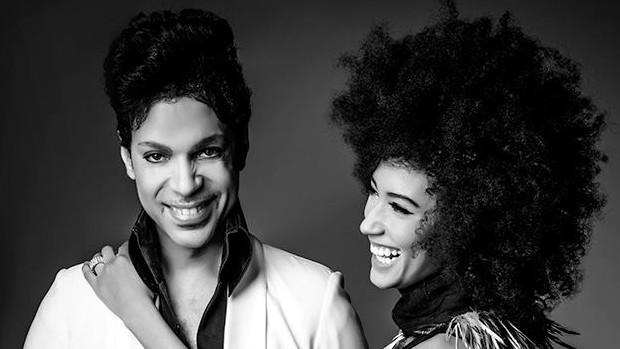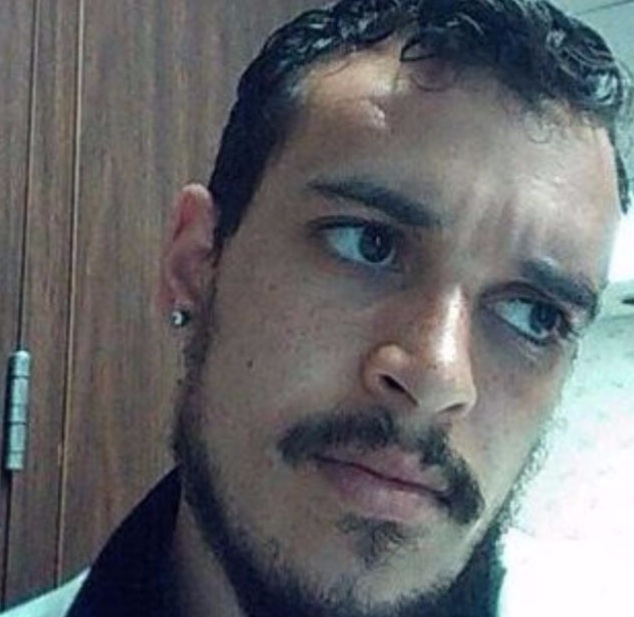By CAROLINE PALMER
Special to the Star Tribune
May 5, 2016 — 12:53pm

HERBERT MIGDOLL
Prince donated the music for the Joffrey Ballet's 1993 work "Billboards," which became a huge hit and helped save the company.
Prince not only found his voice in Minneapolis, but also his moves.
In the days after his death, the stories keep coming about how Prince honed his craft and encouraged potential in others, urging protégés to dance like it’s a higher calling. He certainly set a great example, drawing upon a range of influences, including singer/dancer extraordinaire James Brown, to create his own sort of funky grace.
Prince’s excellence inspired others. Jessica Cressey, a dancer drawn to Minneapolis because of her idol, recounted a conversation in which choreographer Morgan Thorson asked her, “What motivates you through hard shows?” Cressey replied, “I have to set the stakes really high. What if Prince shows up?”
It was an unwritten rule that everyone danced on Prince’s stage, from the band members to the unparalleled Cat Glover (“Sign o’ the Times”) and Misty Copeland, the first black woman promoted to principal at American Ballet Theatre. Prince’s first wife, Mayte Garcia, was a dynamo who reflected every rhythm in her body. He seemed to appreciate anyone who could get in a groove with him — and keep up.
While growing up, Prince had ballet training through an initiative called the Urban Arts Program. It connected students “who didn’t fit into the traditional academic world” with local arts institutions, explained Minnesota Dance Theatre (MDT) artistic director Lise Houlton.
Prince took classes with MDT in Dinkytown. Houlton’s mother, company founder Loyce Houlton, became a mentor and close friend.


Minnesota Dance Theatre founder Loyce Houlton with Prince at the MDT benefit Aug. 3, 1983 at First Avenue. She later wrote of that moment: "Prince came out to sing several encores. Then the high-flying evening was coming to an end. My staff had 'choreographed' that I should go on stage and present Prince with a single purple rose. They told me to say nothing. But when Prince came back to the stage, I stepped up to the microphone and said 'He's not a Prince -- he's a King.' And then Prince ran to me, and with a hug and kiss I gave him the rose."
“He was very good to her,” said Lise. “He would bring her out to Los Angeles for film premieres. They shared stories and dance information. He would bring people who influenced him to the sound checks of his performances, which were even more interesting than the shows. He really used everything he experienced in those dance classes.”
She continued with a catch in her voice, “It makes me so proud of my mother.”
Prep for ‘Purple Rain’
Prince’s loyalty to Loyce continued as his star rose. He headlined a benefit concert for MDT at First Avenue in 1983 that rang up $23,000 for the company’s coffers. The evening included choreography by Loyce to “D.M.S.R.” while Prince made history with the first live performance of his anthem “Purple Rain.”
During this period Prince used the MDT studios at Hennepin Center for the Arts to rehearse for his film debut. John Command, an actor and choreographer with a résumé stretching from Hollywood to the Chanhassen Dinner Theatres, was teaching jazz dance at MDT when Loyce called with a unique offer.
“She told me there’s a rock band that wants to take dance classes,” Command said. “They were willing to pay $150 an hour for four hours a week. They would pay whether they took the class or not, and it would be for six months.” According to Command, members of the Revolution showed up, along with the Time, Denise “Vanity” Matthews and Apollonia Kotero.
Command said he didn’t know who Prince was.
“He was so shy, and so dear. He wore pedal-pusher tights, T-shirts and ballet slippers. He was so darling, it took him two months to look me in the eye.” Command snagged a job choreographing for “Purple Rain” (and also wound up dancing in Michael Jackson’s “Thriller” video).
Ballet of the Dolls dancer Valerie Torres-Comvalius studied at MDT as a girl.
“My sister Vanessa and I would sneak up to the studio to spy, watching him in his skintight purple pants, heels and matching bandanna on his head, gold cross necklace hanging from his neck, practicing his turns over and over,” she said.
“His bodyguard, Big Chick, would come out and yell in a booming voice, ‘What are you kids doing here?!’ scaring the hell out of us, but then would proceed to let us stay and continue watching.”
Prince “had such a phenomenal work ethic, and so do most dancers,” she said. “So I suppose he could really relate to just how much goes into it all.”
Saving the Joffrey Ballet
MDT wasn’t the only dance company Prince cared about. During the early 1990s, Joffrey Ballet donor Patricia Kennedy brought him to a performance in Los Angeles. Prince was so inspired he offered to write music for a new piece.
He not only wrote an extended version of his song “Thunder” from the album “Diamonds and Pearls” but also permitted use of his music free of charge for five years with no royalty expectations. It helped save the financially foundering company.
Prince’s generosity led to the rock ballet “Billboards.” When it premiered in 1993 in Iowa City, the audience roared. “We were used to hearing some ‘bravos’ and polite applause,” said longtime company member Suzanne Lopez. “But this was like being at a rock concert. We knew it would be a hit. And for five years that is almost exclusively what we did.”


Prince at a benefit concert for Minnesota Dance Theatre at First Avenue on Aug. 3, 1983, when he premiered (and recorded) much of his music for "Purple Rain," including the title song.
As “Billboards” sold out theaters across the nation, it became “a testament to [Prince’s] artistic ability to bring attention to our community and enhance new aspects of our dance world,” said Lynn Von Eschen, executive director of the Cowles Center in Minneapolis.
Washington Post dance journalist Sarah Kaufman observed that “Billboards” was “emblematic of his genius in that each song was a whole universe of feeling and imagery and atmosphere without being prescriptive. Prince had such a poetic style that it could inspire another creative response from the dancers.”
Forming his own troupe
During the early 1990s, when Prince was affiliated with the Minneapolis nightclub Glam Slam, he formed a dance company, led by choreographer Kat Carroll, with Jamie King, Leah Nelson and others also contributing. The troupe had various names including Glam Slam, Erotic City and Club 110 dancers.
Prince “was as meticulous with the dancers as he was with the musicians,” Carroll said. “We worked very hard, and he treated us very well and he paid us very well. But he also expected us to be on top of things, just like his musicians. We worked long hours, many times during the week.”
Company member Colleen McClellan Ueland remembers his openness to ideas. “He really appreciated your individual style. He did not stock his club with dancers who all looked the same. I was a plain Jane girl, but I got to stay because I could really dance to that music. I could have gone to Los Angeles with my looks and not gotten any work.”
Prince was battling with his label Warner Bros. Records at the time and much of the music the dancers used was unreleased. In addition to top-notch hairstyling and make-up, they had access to a dazzling array of costumes — including clothes that had been designed personally for Prince. (Many of these “rejects” were tight on even the smallest dancers, McClellan Ueland recalled.
A favorite memory is Prince performing an entire set behind a curtain, showing only his guitar and hands briefly, driving the crowd crazy.


An MDT call sheet for the day of Prince's 1983 benefit, which included a performance of his song "D.M.S.R." choreographed by Loyce Houlton. (courtesy of Minnesota Dance Theatre Records Performing Arts Archives, University of Minnesota)
“That’s the kind of power he had,” she said. “No one could get mad at him, and people would go home with a story. His sense of humor was so special. He was always [messing] with everybody.”
She said, “Those two years dancing for him were so formative. It was all I needed to catapult my dance career for the next 25 years.”
The dancers also appeared in videos and were tasked with summoning fans to Paisley Park performances. Carroll was a key collaborator in 1994’s “Prince Interactive” CD-ROM that included video games, music and a virtual tour of Paisley Park. She credited Prince with instilling in her a strong “work ethic, artistry, drive and passion,” and for reminding her to always look to others for inspiration as well as herself.
“He believed in me and taught me that if I would eat, sleep and drink my work, I could reach my biggest potential.”
Caroline Palmer is a longtime Twin Cities dance critic.
Quelle
Prince in radlerhosen und ballettschläppis ... *kicher*
War mir vollkommen neu, dass Prince mit seinen songs den soundteppich für das rock ballet BILLBOARDS lieferte. Link hier *klick*
Live performance von D.M.S.R. (was Dance Musik Sex Romance meint) Detroit 2004.
Immer mächtig was los auf der bühne, Prince kommunikativ unterwegs immer am draht zum publikum.
Man merkt, dass er selbst und seine band spass an dem ganzen tohuwabohu haben und weiss, wie er das publikum auf touren bringt.
Geniale spielfreude nenne ich sowas !!
 Rest in purple peace
Rest in purple peace























 .... werd nicht müde ihn zu hören.
.... werd nicht müde ihn zu hören.




Kommentar